NCERT Solutions for Class 10 Science Chapter 4 Carbon and its Compounds
The Class 10 NCERT Solutions for Science Chapter 4 Carbon and its Compounds includes all the intext and exercise questions. Class 10 Science Chapter 4 Carbon And Its Compounds NCERT questions and answers help students to clear their doubts and to obtain good marks in Class 10 board exam. All the solutions provided in this article are strictly based on the CBSE syllabus and curriculum.
Class 10 Science Chapter 4 NCERT Questions and Answers
Class 10 Science Chapter 4 Carbon and its Compounds NCERT Questions and Answers are prepared by experts with a detailed explanation that will help students complete their assignments & homework. Having a good grasp over CBSE NCERT Solutions for Class 10 Science will further help the students in their preparation for board exams and other competitive exams such as NTSE, Olympiad, etc.
NCERT Solutions for Class 10 Science Chapter 4 Intext Questions
Intext Question (Page No. 61)
Question 1: What would be the electron dot structure of carbon dioxide which has the formula CO2
Answer: Electron dot structure of CO2 is
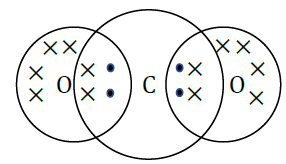
Question 2: What would be the electron dot structure of a molecule of sulphur which is made up of eight atoms of sulphur? (Hint − the eight atoms of sulphur are joined together in the form of a ring.)
Answer: Electron dot structure of a Sulphur molecule
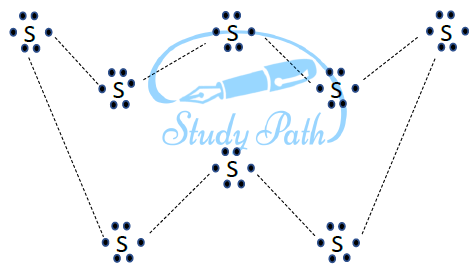
Intext Question (Page No. 61)
Question 1: How many structural isomers can you draw for pentane?
Answer: Three structural isomers are possible for pentane.
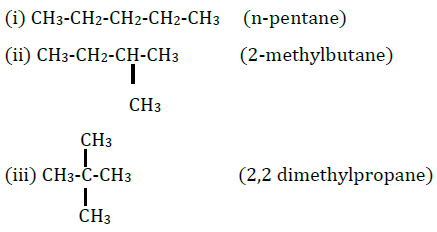
Question 2: What are the two properties of carbon which lead to the huge number of carbon compounds we see around us?
Answer: The two features of carbon that give rise to a large number of compounds are as follows:
Catenation: It is the ability to form bonds with other atoms of carbon.
Tetravalency: With the valency of four, carbon is capable of bonding with four other atoms.
Question 3: What will be the formula and electron dot structure of cyclopentane?
Answer: The formula for cyclopentane is . Its electron dot structure is given below.
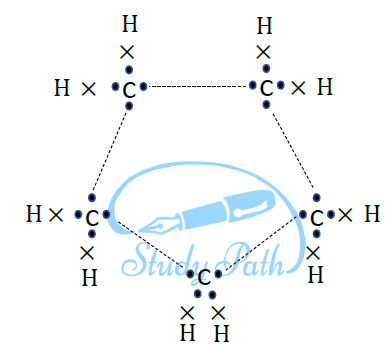
Question 4: Draw the structures for the following compounds.
(i) Ethanoic acid
(ii) Bromopentane*
(iii) Butanone
(iv) Hexanal
*Are structural isomers possible for bromopentane?
Answer: (i) CH3-COOH
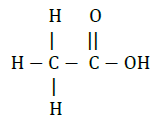
(ii) There are many structural isomers possible for Bromopentane. Among them, the structures of three isomers are given.
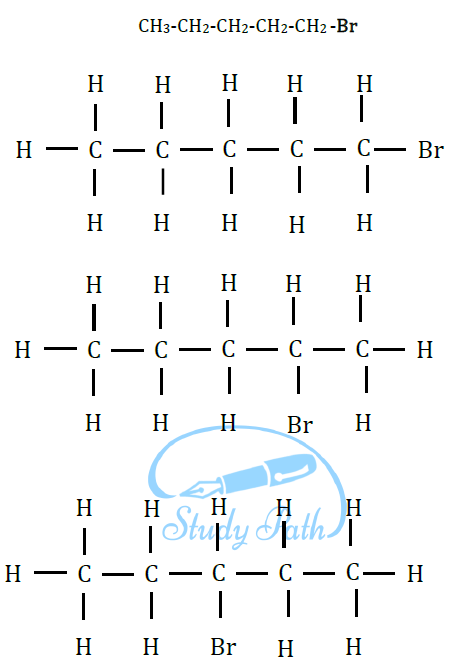
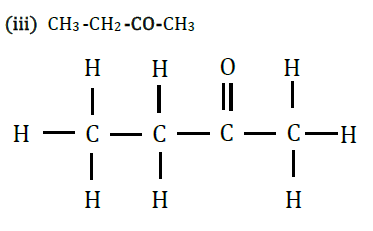
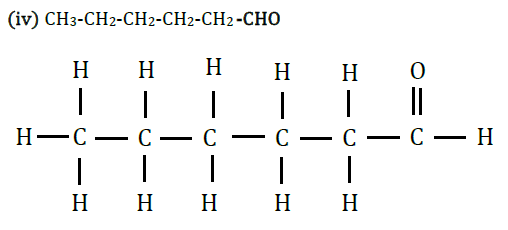
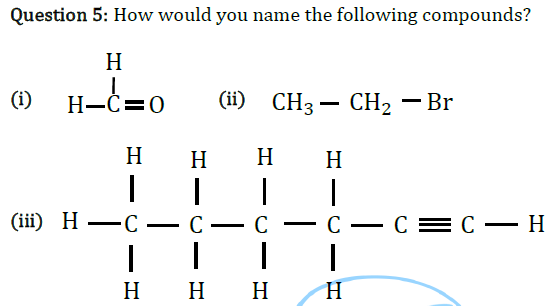
Answer: (i) Bromoethane
(ii) Methanal
(iii) Hexyne
Intext Question (Page No. 71)
Question 1: Why is the conversion of ethanol to ethanoic acid an oxidation reaction?

Answer: Since the conversion of ethanol to ethanoic acid involves the addition of oxygen to ethanol, it is an oxidation reaction.
Conversion of ethanol to ethanoic acid involves the removal of Hydrogen atom and addition of oxygen it is an oxidation reaction. In the first step, a H2 molecule is removed from ethanol to form ethanal. As loss of Hydrogen is oxidation so, the reaction is an oxidation reaction. Similarly oxygen atom is added to form ethanoic acid from ethanal. As, gain of Oxygen is called oxidation so, the reaction is an oxidation reaction.
Question 2: A mixture of oxygen and ethyne is burnt for welding. Can you tell why a mixture of ethyne and air is not used?

When ethyne is burnt in air, it gives a sooty flame. This is due to incomplete combustion caused by limited supply of air. However, if ethyne is burnt with oxygen, it gives a clean flame with temperature 3000°C because of complete combustion. This oxy-acetylene flame is used for welding. It is not possible to attain such a high temperature without mixing oxygen. This is the reason why a mixture of ethyne and air is not used.
Intext Question (Page No. 74)
Question 1: How would you distinguish experimentally between an alcohol and a carboxylic acid?
Answer: On reaction with Sodium Carbonate, Carboxylic acids produces carbon dioxide gas which turns lime water milky whereas alcohols do not give this reaction. This experiment can be used to distinguish an alcohol and carboxylic acid.
Question 2: What are oxidizing agents?
Answer: Oxidising agents are those compounds which either removes Hydrogen or adds oxygen to a compound. Ex: halogens, potassium nitrate, and nitric acid.
Intext Question (Page No. 76)
Question 1: Would you be able to check if water is hard by using a detergent?
Answer: Detergents are ammonium or Sulphonate salts of long chain carboxylic acids. Unlike soap, they do not react with calcium and magnesium ions present in hard water to form scum. They give a good amount of lather irrespective of whether the water is hard or soft. This means that detergents can be used in both soft and hard water. Therefore, it cannot be used to check whether the water is hard or not.
Question 2: People use a variety of methods to wash clothes. Usually after adding the soap, they ‘beat’ the clothes on a stone, or beat it with a paddle, scrub with a brush or the mixture is agitated in a washing machine. Why is agitation necessary to get clean clothes?
Answer: Agitation is necessary to get clean clothes as agitation aid soap micelles to trap the oil, grease or any other impurities that have to be removed. When they are being beaten or agitated, the particles are removed from the clothes’ surfaces and go into the water, thus cleaning the clothes.
NCERT Solutions for Class 10 Science Chapter 4 Exercise Questions
Question 1: Ethane, with the molecular formula C2H6 has
(a) 6 covalent bonds.
(b) 7 covalent bonds.
(c) 8 covalent bonds.
(d) 9 covalent bonds.
Answer: (b) 7 covalent bonds.
Question 2: Butanone is a four-carbon compound with the functional group
(a) carboxylic acid.
(b) aldehyde.
(c) ketone.
(d) alcohol.
Answer: (c) ketone.
Question 3: While cooking, if the bottom of the vessel is getting blackened on the outside, it means that
(a) the food is not cooked completely.
(b) the fuel is not burning completely.
(c) the fuel is wet.
(d) the fuel is burning completely.
Answer: (b) the fuel is not burning completely
Question 4: Explain the nature of the covalent bond using the bond formation in .
Answer: Carbon can neither lose four of its electrons nor gain four electrons as both the processes require extra amount of energy and would make the system unstable. Therefore, it completes its octet by sharing its four electrons with other carbon atoms or with atoms of other elements. The bonds that are formed by sharing electrons are known as covalent bonds. In covalent bonding, both the atoms share the valence electrons, i.e., the shared electrons belong to the valence shells of both the atom.
Here, carbon requires 4 electrons to complete its octet, while each hydrogen atom requires one electron to complete its duplet. Also, chlorine requires an electron to complete the octet. Therefore, all of these share the electrons and as a result, carbon forms 3 bonds with hydrogen and one with chlorine.
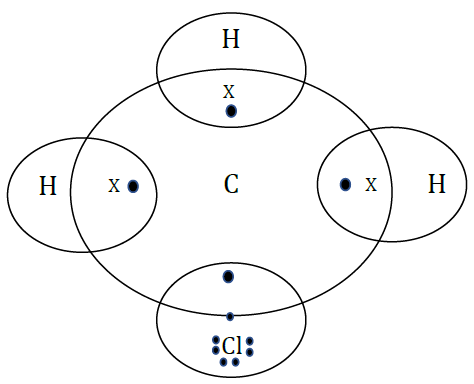
Question 5: Draw the electron dot structures for
(a) ethanoic acid.
(b) H2S
(c) propanone.
(d) F2
Answer:
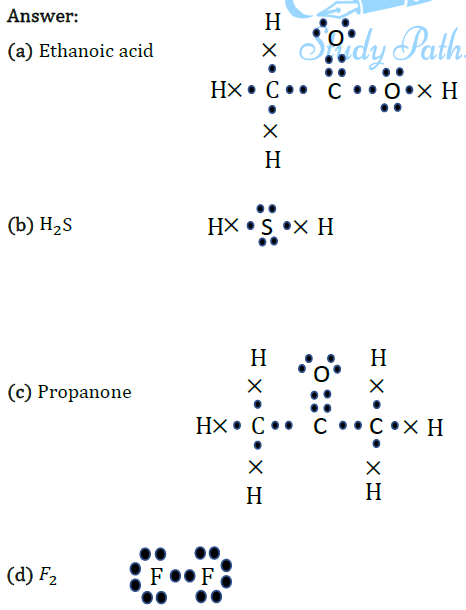
Question 6: What is a homologous series? Explain with an example.
Answer: A homologous series is a series of carbon compounds that have different numbers of carbon atoms but contain the same functional group. For example, methane, ethane, propane, butane, etc. are all part of the alkane homologous series. The general formula of this series is
Methane → CH4
Ethane → CH3CH3
Propane → CH3CH2CH3
Butane → CH3CH2CH2CH3
It can be noticed that there is a difference of — CH2 unit between each successive compound.
Question 7: How can ethanol and ethanoic acid be differentiated on the basis of their physical and chemical properties?
Answer:
| Ethanol | Ethanoic acid |
| Does not react with sodium hydrogen carbonate | Bubbles and fizzes with hydrogen carbonate |
| Good smell | Smells like vinegar |
| No action in litmus paper | Blue litmus paper to red |
| Burning taste | Sour taste |
Question 8: Why does micelle formation take place when soap is added to water? Will a micelle be formed in other solvents such as ethanol also?
Answer: A soap is a sodium or potassium salt of long chain fatty acids. It has one polar end and one non-polar end. The polar end is hydrophilic in nature i.e., this end is attracted towards water. The non-polar end is hydrophobic but lipophilic, i.e., it is attracted towards hydrocarbons. When soap is added to water, soap molecules arrange themselves in a cluster to keep the non-polar portion out of water such that the non-polar ends are in the interior of the cluster and the polar ends are on the surface of the cluster. Since the dirt present on clothes is organic in nature and insoluble in water, the hydrophobic ends of the clusters attach themselves to the dirt. This cluster formation in which the dirt is entrapped is the micelle.
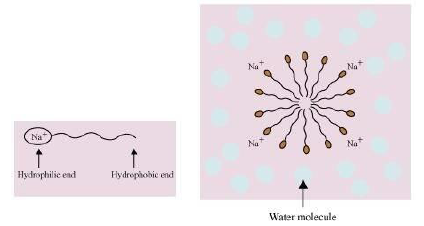
Micelle formation does not occur in alcohol because the alkyl chain of soap becomes soluble in alcohol.
Question 9: Why are carbon and its compounds used as fuels for most applications?
Answer: Carbon and its compounds used as fuels for most applications for they have high calorific values and give out a lot of energy. Most of the carbon compounds give a lot of heat and light when burnt in air.
Question 10: Explain the formation of scum when hard water is treated with soap.
Answer: Soap does not work properly when the water is hard. A soap is a sodium or potassium salt of long chain fatty acids. Hard water contains salts of calcium and magnesium. When soap is added to hard water, calcium and magnesium ions present in water displace sodium or potassium ions from the soap molecules forming an insoluble substance called scum. A lot of soap is wasted in the process.
Question 11: What change will you observe if you test soap with litmus paper (red and blue)?
Answer: When we test soap with litmus paper color of litmus paper turns blue from red. As soap is a base it turn red litmus paper into blue.
Question 12: What is hydrogenation? What is its industrial application?
Answer: Hydrogenation is a process or a chemical reaction between hydrogen and other compounds. It is usually done in the presence of catalysts: for example nickel, palladium or platinum. Hydrogenation is used mainly to saturate organic compounds.

Question 13: Which of the following hydrocarbons undergo addition reactions: C2H6, C3H8, C3H6, C2H2 and CH4.
Answer: Unsaturated hydrocarbons undergo addition reactions. Being unsaturated hydrocarbons, and undergo addition reactions.
Question 14: Give a test that can be used to differentiate chemically between butter and cooking oil.
Answer: Bromine water test – is used to differentiate between the unsaturated compounds (like alkenes and alkynes) and the saturated compounds. For this purpose, bromine is used in the form of bromine water. A solution of bromine in water is called bromine water. Bromine water has a red-brown color due to the presence of bromine in it. When bromine water is added to an unsaturated compound, then bromine gets added to the unsaturated compound and the red-brown color of bromine water is discharged. So, if an organic compound decolorizes bromine water, then it will be an unsaturated hydrocarbon (containing a double bond or a triple bond), but saturated hydrocarbon (alkanes) do not decolorize bromine water.
Bromine water test is perform to differentiate between the unsaturated compounds (like alkenes and alkynes) and the saturated compounds. Bromine water is added to an un-saturated hydrocarbon red brown color of bromine solution is discharged. Si if there is dis-coloration then the compound will be an unsaturated Hydrocarbon.
Question 15: Explain the mechanism of the cleaning action of soaps.
Answer: Cleansing action of soaps: The dirt present on clothes is organic in nature and insoluble in water. Therefore, it cannot be removed by only washing with water. When soap is dissolved in water, its hydrophobic ends attach themselves to the dirt and remove it from the cloth. Then, the molecules of soap arrange themselves in micelle formation and trap the dirt at the centre of the cluster. These micelles remain suspended in the water. Hence, the dust particles are easily rinsed away by water.
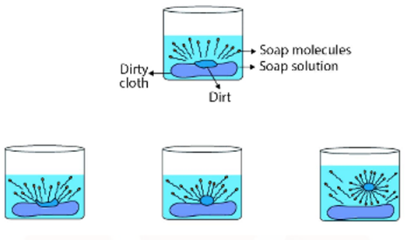
Topics covered under Class 10 Science Chapter 4 Carbon And Its Compounds
Below we have listed the topics discussed in NCERT Solutions for Class 10 Science Chapter 4. The list gives you a quick look at the different topics and subtopics of this chapter.
| Section in NCERT Book | Topics Discussed |
|---|---|
| 4.1 | The Covalent Bond |
| 4.2 | Versatile Nature of Carbon |
| 4.2.1 | Saturated and Unsaturated Compounds |
| 4.2.5 | Nomenclature of Carbon compounds |
| 4.3 | Chemical Properties of Carbon Compounds |
| 4.3.4 | Addition Reaction |
| 4.3.4 | Substitution Reaction |
| 4.4 | Some Important Carbon Compounds |
NCERT Solutions for Class 10 Science Chapter 4 – A Brief Discussion
Chapter Overview: In this chapter you will learn about Carbon and its Compound. The chapter mainly discusses about the characteristics of Carbon. This includes the versatile nature of carbon. Further, you will study the saturated and unsaturated compounds of carbon, chains, branches and ring structure of carbons. Going through the chapter you will also learn how different carbon compounds got their name. Moreover, the chapter also covers the topics like isomers, alkanes, alkenes, alkynes, allotropes of carbon and the fundamentals of a homologous series. At last the chapter Carbon and its compound provide insights into the properties of Ethanol and Ethanoic acid.